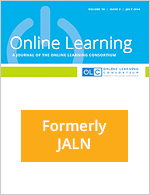Increasing Access in Online Higher Education
This paper investigates how access to higher education in the United States can be increased through further integration of online education. The search for opportunities to increase access to online education examined multiple prospective higher education contexts. A series of papers produced by participants in the 2005 Sloan-C summer workshop...

